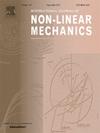Analysis and control of coexisting attractor transitions in a class of rigid vibro-impact systems
IF 2.8
3区 工程技术
Q2 MECHANICS
International Journal of Non-Linear Mechanics
Pub Date : 2025-02-24
DOI:10.1016/j.ijnonlinmec.2025.105066
引用次数: 0
Abstract
In order to solve the problem that coexisting attractor transition control is not easy to achieve in rigid vibro-impact systems, the coexisting attractors and the transition control of a single-degree-of-freedom vibro-impact system with clearance is explored in this paper. Firstly, the Poincaré map of system and its Jacobi matrix are obtained by constructing the local map. Secondly, the coexistence and transition characteristics between stable and unstable periodic motions are studied by the cell mapping method, the shooting method, and parameter continuation algorithms. Finally, with the boundary point being whether a collision occurs between the controlled system and the target system, a piecewise controller based on Lyapunov stability theory and the backstepping method is proposed to adapt to the rigid vibro-impact system with clearance and multistability coexistence. The controller employs the impact occurrence between the controlled system and the target system as the boundary point. Numerical simulation results demonstrate that the designed controller can effectively control the transition of the attractors.
一类刚性冲击系统中共存吸引子过渡的分析与控制
为了解决刚性振动冲击系统中不易实现共存吸引子过渡控制的问题,本文对带间隙的单自由度振动冲击系统的共存吸引子与过渡控制进行了研究。首先,通过构造局部映射得到系统的poincar映射及其Jacobi矩阵;其次,采用单元映射法、射击法和参数延拓算法研究了稳定与不稳定周期运动的共存与过渡特征;最后,以被控系统是否与目标系统发生碰撞为边界点,提出了一种基于Lyapunov稳定性理论和反演方法的分段控制器,以适应具有间隙和多稳定共存的刚性振动冲击系统。控制器采用被控系统与目标系统之间的碰撞发生点作为边界点。数值仿真结果表明,所设计的控制器能够有效地控制吸引子的过渡。
本文章由计算机程序翻译,如有差异,请以英文原文为准。
求助全文
约1分钟内获得全文
求助全文
来源期刊
CiteScore
5.50
自引率
9.40%
发文量
192
审稿时长
67 days
期刊介绍:
The International Journal of Non-Linear Mechanics provides a specific medium for dissemination of high-quality research results in the various areas of theoretical, applied, and experimental mechanics of solids, fluids, structures, and systems where the phenomena are inherently non-linear.
The journal brings together original results in non-linear problems in elasticity, plasticity, dynamics, vibrations, wave-propagation, rheology, fluid-structure interaction systems, stability, biomechanics, micro- and nano-structures, materials, metamaterials, and in other diverse areas.
Papers may be analytical, computational or experimental in nature. Treatments of non-linear differential equations wherein solutions and properties of solutions are emphasized but physical aspects are not adequately relevant, will not be considered for possible publication. Both deterministic and stochastic approaches are fostered. Contributions pertaining to both established and emerging fields are encouraged.

 求助内容:
求助内容: 应助结果提醒方式:
应助结果提醒方式:


